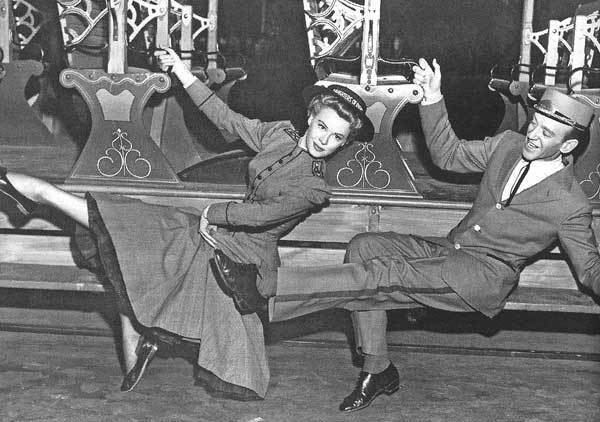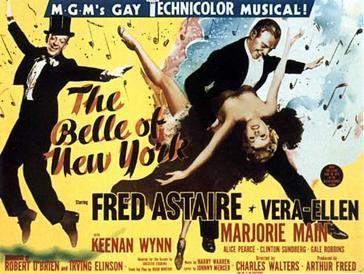4.2 /10 1 Votes4.2
22% Rotten Tomatoes Running time 82 minutes Screenplay Robert O'Brien | 6.2/10 IMDb Initial release 22 February 1952 Box office 1.982 million USD | |||||||||||||||||||||||||||||||||
 | ||||||||||||||||||||||||||||||||||
Starring Fred AstaireVera-EllenMarjorie MainKeenan Wynn Release date February 22, 1952 (U.S. release) Cast | ||||||||||||||||||||||||||||||||||
The Belle of New York is a 1952 Metro-Goldwyn-Mayer Hollywood musical comedy film set in New York circa 1900 and stars Fred Astaire, Vera-Ellen, Alice Pearce, Marjorie Main, Gale Robbins and Keenan Wynn, with music by Harry Warren and lyrics by Johnny Mercer. The film was directed by Charles Walters.
Contents

This whimsical (even by Astaire's standards) musical failed at the box office and impressed few critics at the time, mainly due to the nature of the plot which empowers lovers to float free of the influence of gravity - a conceit reprised in the 1999 film Simply Irresistible. Astaire was reluctant to take the project - he was originally supposed to play the role in 1946 but had avoided it through retirement. Clearly stung by its failure, Astaire later claimed that the dance routines - of which there are more than usual - are of a particularly high standard - a rare verdict from such a notoriously self-critical artist. Vera-Ellen is generally viewed as one of Astaire's most technically proficient dance partners, and this was a factor in his readiness to expand the dance content of the film beyond its traditional proportions.

Plot
Set in turn-of-the-century New York, wealthy playboy Charles Hill (Fred Astaire) is causing difficulties for his guardian, Aunt Lettie (Marjorie Main) and lawyer, Max (Keenan Wynn). Prone to fall in love then ditching his showgirl brides-to-be at the altar, the compensation bills are mounting. After the most recent episode, he hears Angela (Vera-Ellen) leading a Salvation Army band in song. He falls in love at first sight and when she scoffs at him, telling him that if he were in love his feet would leave the ground, he promptly floats high into the air. He pursues her, even vowing to do an honest day's work for the first time in his life. After various attempts to convince her, Angela's feeling finally cause her feet to leave the ground. After a couple of misunderstandings are resolved, they float into the air together, to a chorus of well-wishers below.
Musical numbers
The choreography makes play with ideas of lightness, of floating on air and on ice, and the use of platforms, with Astaire consciously avoiding his usual love of noise-making in his solos. Vera-Ellen's lithe and waif-like figure (she suffered from anorexia nervosa in real life) facilitated this concept. This also marks choreographer Robert Alton's last collaboration with Astaire.
Reception
According to MGM records the film earned $1,340,000 in the US and Canada and $642,000 elsewhere, resulting in a loss of $1,576,000.
Songs
1When I'm out with the Belle of New YorkAdolph Deutsch & His Orchestra2:04
2Seeing's BelievingFred Astaire2:15
3Baby DollFred Astaire2:25
